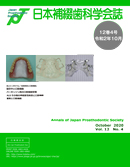Volume 12, Issue 4
October 2020
Displaying 1-13 of 13 articles from this issue
- |<
- <
- 1
- >
- >|
Preface
-
Article type: Preface
2020Volume 12Issue 4 Pages 305-306
Published: 2020
Released on J-STAGE: October 24, 2020
Download PDF (831K)
Invited Articles
-
Article type: Invited Article
2020Volume 12Issue 4 Pages 309-315
Published: 2020
Released on J-STAGE: October 24, 2020
Download PDF (1776K) -
Article type: Invited Article
2020Volume 12Issue 4 Pages 316-321
Published: 2020
Released on J-STAGE: October 24, 2020
Download PDF (3858K) -
Article type: Invited Article
2020Volume 12Issue 4 Pages 322-329
Published: 2020
Released on J-STAGE: October 24, 2020
Download PDF (1909K) -
Article type: Invited Article
2020Volume 12Issue 4 Pages 330-336
Published: 2020
Released on J-STAGE: October 24, 2020
Download PDF (1124K)
Case Report
-
Article type: case-report
2020Volume 12Issue 4 Pages 337-343
Published: 2020
Released on J-STAGE: October 24, 2020
Download PDF (2818K)
Case Reports (Specialist)
-
Article type: case-report
2020Volume 12Issue 4 Pages 344-347
Published: 2020
Released on J-STAGE: October 24, 2020
Download PDF (1540K) -
Article type: case-report
2020Volume 12Issue 4 Pages 348-351
Published: 2020
Released on J-STAGE: October 24, 2020
Download PDF (1640K) -
Article type: case-report
2020Volume 12Issue 4 Pages 352-355
Published: 2020
Released on J-STAGE: October 24, 2020
Download PDF (1648K) -
Article type: research-article
2020Volume 12Issue 4 Pages 356-359
Published: 2020
Released on J-STAGE: October 24, 2020
Download PDF (2164K) -
Article type: case-report
2020Volume 12Issue 4 Pages 360-363
Published: 2020
Released on J-STAGE: October 24, 2020
Download PDF (1428K) -
Article type: case-report
2020Volume 12Issue 4 Pages 364-367
Published: 2020
Released on J-STAGE: October 24, 2020
Download PDF (2520K) -
Article type: case-report
2020Volume 12Issue 4 Pages 368-371
Published: 2020
Released on J-STAGE: October 24, 2020
Download PDF (1574K)
- |<
- <
- 1
- >
- >|
